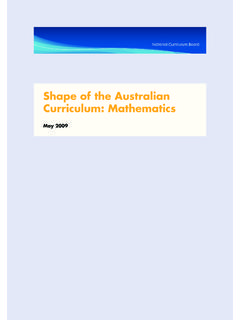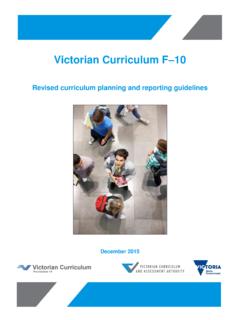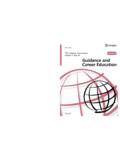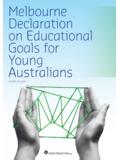Transcription of Teaching and Learning Languages
1 Teaching and Learning LanguagesA GuideTeaching and Learning Languages A Guide Angela Scarino and Anthony J LiddicoatISBN 978-1-74200-081-79781742000817 Teaching and Learning Languages : A Guide is a key part of the Australian Government s commitment to educating young Australians. The Government recognises that the skills and knowledge necessary to communicate and work with diverse Languages and cultures must be a core element of the Australian school Guide is designed to lead language education in new directions and to help create inspiring Learning environments. It invites teachers of Languages to think about the content, process and outcomes of their work in Teaching , Learning and assessment. It is a resource for reflecting on Languages education, the role of Languages teachers, and their programs and pedagogies in relation to contemporary educational understandings and contexts. The Guide presents recent work by members of the Languages Teaching profession, both teachers and researchers, based in classrooms, schools and universities.
2 It pulls together the expertise that is available at a number of levels in this country in order to ensure an enriching language Learning experience for all Australian students and to further develop Australia s international potential and Guide is available, and is supported by additional materials, at Scarino and Anthony J LiddicoatTeaching and Learning LanguagesA GuideAngela Scarino andAnthony J LiddicoatTeaching and Learning Languages : A Guide was funded by the Australian Government Department of Education, Employment and Workplace : 978 1 74200 081 7 SCIS order number: 1393292 Full bibliographic details are available from Curriculum and Learning Languages : A Guide is also available on the website by Curriculum Corporation PO Box 177 Carlton South Vic 3053 Australia Tel: (03) 9207 9600 Fax: (03) 9910 9800 Email: Website: Commonwealth of Australia 2009 This work is copyright. It may be reproduced in whole or in part for study or training purposes subject to the inclusion of an acknowledgment of the source and no commercial usage or sale.
3 Reproduction for purposes other than those indicated above, requires the prior written permission from the Commonwealth. Requests and inquiries concerning reproduction and rights should be addressed to Commonwealth Copyright Administration, Attorney General s Department, Robert Garran Offices, National Circuit, Barton ACT 2600 or posted views expressed in the publication do not necessarily represent the views of the Australian Government Department of Education, Employment and Workplace by GEON Impact Printing Pty LtdThe Australian Government is committed to Languages education in Australian schools and recognises the important role it plays in equipping young Australians with the knowledge, skills and capabilities to communicate and work with our international neighbours. The Government is making a substantial investment in Australia s schools. The new National Education Agreement will provide $18 billion to the states and territories over the period 2009 to 2012, offering flexibility to target resources towards key areas such as Languages development of Teaching and Learning Languages : A Guide represents a key part of the Government s commitment to support teachers in delivering quality language education programs for all young Australians.
4 Learning a language should involve understanding how Languages and cultures are a fundamental part of people s lives. Teaching Languages from an intercultural perspective improves the engagement and Learning outcomes of students of Languages in Australian Guide is a multi-modal package that is accompanied by a series of web-based materials which provide online practical examples of how the principles for developing intercultural language Learning outlined in this Guide can be incorporated in language education. The online examples are drawn from the work of experienced language teachers who are working to implement new ways of Teaching and Learning in their classrooms. This Guide is a significant new resource for teachers, schools and communities, which can be used to create inspiring language Learning environments. It will give students the opportunity to come to understand their own place in the world through their language Learning , and will help them to use their Learning to develop Australia s economic, social and cultural relations in an increasingly globalised commend this Guide and hope teachers will find it useful in their language Teaching Gillard Minister for EducationForewordAcknowledgments The authors wish to acknowledge the contributions of those who participated in the project to produce this Guide and the supporting online materials.
5 Development of Teaching and Learning Languages : A Guide was funded by the Department of Education, Employment and Workplace Relations under the Australian Government s School Languages Program (SLP). It supports some of the actions recommended in the National Statement for Languages Education in Australian Schools and the National Plan for Languages Education in Australian Schools 2005 2008 developed through the Ministerial Council on Education, Employment, Training and Youth Affairs (MCEETYA) relating to the strengthening and promoting of quality Teaching and Learning practices and supporting the provision of high quality, ongoing and structured professional Learning project was developed by the Research Centre for Languages and Cultures (RCLC) at the University of South Australia. Thanks to Jim Dellit for his editorial work on the Guide, and to Ari Bickley for the design. The Project Advisory Group Judy Gordon, Thomas Natera and Georgia Bray, representing the Australian Government Department of Education, Employment and Workplace Relations (DEEWR)Joe van Dalen, representing the Australian Federation of Modern language Teachers Associations (AFMLTA)Meredith Beck and Ghislaine Barbe, representing a non-government education jurisdictionTamara Romans, representing a state/territory government education jurisdictionJacqueline von Wersch, representing an ethnic/community Languages school providerAnn Bliss, representing a national parents bodyThe RCLC project team Associate Professor Angela Scarino (Project Director)Professor Anthony J Liddicoat (Project Director)Dr Jonathan CrichtonDr Timothy J CurnowJim DellitMichelle KohlerKate LoechelNives MercurioDr Anne-Marie MorganAndrew ScrimgeourDr Kazuyo TaguchiContentsPurpose.
6 1 Using the Guide ..3 Developing a personal, professional stance ..4 Working with complexity and change ..5 Understanding contemporary contexts ..7 What is language ? ..15 What is culture? ..19 Understanding Learning ..24 Understanding language Learning ..30 Intercultural language Learning ..33 Classroom interactions ..37 The nature of interactional language ..41 Tasks and task-types ..45 Student engagement ..49 The diversity of learners and their life-worlds ..50 Scaffolding Learning ..54 Technologies in language Teaching and Learning ..55 The purposes of resources ..57 Selecting resources ..59 Authentic resources ..60 Adapting resources ..61 Contemporary resources ..622 language , Culture and Learning1 Orientation of the Guide3 Teaching and Learning4 Resourcing and MaterialsUsing resources critically ..63 Relating resources to each other ..64 Learners as resources ..65 Developing a resource purposes of assessment ..67 The assessment cycle ..71 Planning language programs.
7 77 Long-term and short-term planning ..82 Planning interactions ..85 Personalising Learning experiences ..85 Evaluation for program renewal ..87 Evaluation in context ..88 Purpose and scope of evaluation ..89 Evaluation as inquiry ..90 Commitment to growth and development ..91 Creating a culture of professional Learning ..92 Contexts of a professional Learning culture ..93 Collaborating for a professional Learning culture .. Assessing6 Programming and Planning9 Further Resources10 References7 Evaluating language Programs8 Developing a Professional Learning CultureOrientation of the Guide1 PurposeThis Guide is a resource for Languages teachers to use in reflecting on Languages education, their role as Languages teachers, and their programs and pedagogies in relation to contemporary educational understandings and contexts. It invites teachers to think about the content, process and outcomes of their work in Teaching , Learning and assessment. The Guide is based on recent work by members of the Languages Teaching profession: teachers and researchers based in classrooms, schools and times this Guide describes the field of Languages Teaching today generally; at times it describes actual practice in schools and in classrooms; and at times it reports on current research and thinking in Languages education.
8 At all times, it seeks to inspire members of our profession to challenge long-held beliefs about the Teaching of Languages with the intention of confirming their worth or changing is language ?What is language ?Purpose1A key message of this Guide is that teachers need to analyse their personal, professional Teaching 'stance': the professional big-picture understanding and position they bring to their work which shapes their programs and pedagogies. This Guide encourages teachers to consider their stance and develop it with regard to: professionalism and knowledge of education, Teaching and Learning personal and professional experience and self-understandings understandings of new and different contexts for students, teachers and communities and their impacts on Learning contemporary understandings, including complexities and ambiguities, of Languages and pedagogy the relationship of experience and past practices to new situations and new understandings as their stance develops and of our personal and professional beliefs, perspectives or commitments are ever static, and the Guide addresses those aspects that teachers think about when considering the development of a personal and professional stance.
9 At the end of each section, there are questions to encourage consideration of these aspects in relation to stance and to invite teachers to make changes to their thinking and to the practices of their key message of this Guide is that teachers need to analyse their personal, professional Teaching stance: the professional big-picture understanding and position they bring to their work which shapes their programs and and Learning Languages : A GuideUsing the GuideThe Guide is supported by additional materials available at These materials consist of a number of related resources designed to support teachers in developing a Teaching stance and the practices that follow. Each section of this Guide is supported online with examples from classroom practice. The examples act as companion guides to the information provided in each section and present Teaching activities in six Languages . These online resources are provided as examples of what real teachers do when they are working in real contexts.
10 They can be used for reflection on Teaching , Learning , assessment and evaluation. We know that teachers learn best from other teachers and so we encourage teachers to look across the sets of examples in all Languages rather than just in Languages they Guide does not purport to be a methodology manual, though the online examples of programs will enable Languages teachers to relate ideas discussed in the Guide to their daily classroom practices. The nature of Teaching and Learning means that teachers are, by nature and necessity, professionals who think about their work with their particular students in their particular context, and who learn and change through thinking and reflecting on practice. This Guide provides an opportunity to engage with the increasingly sophisticated theoretical and practical work of language Teaching and Learning , and using Languages for communication in increasingly diverse material has often come to teachers as prescriptive practices that they have been required to adopt and adapt.







